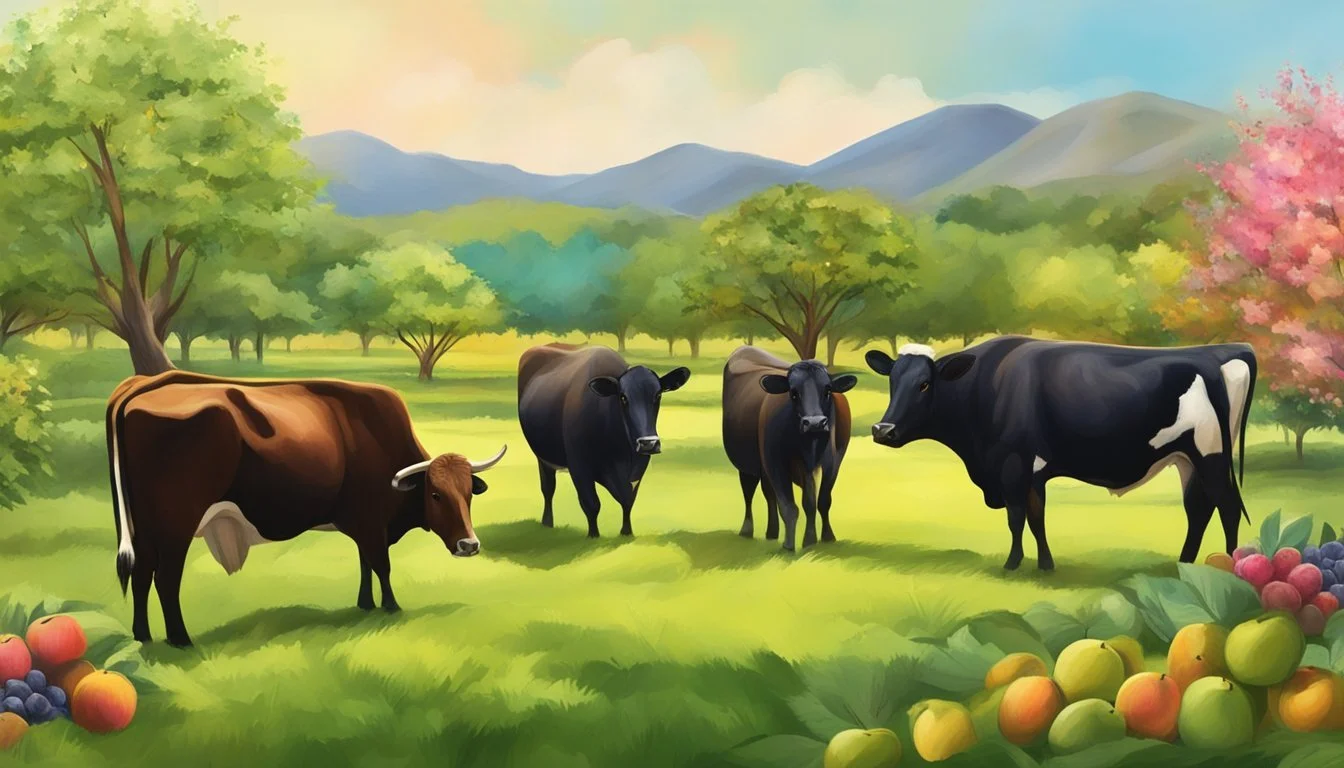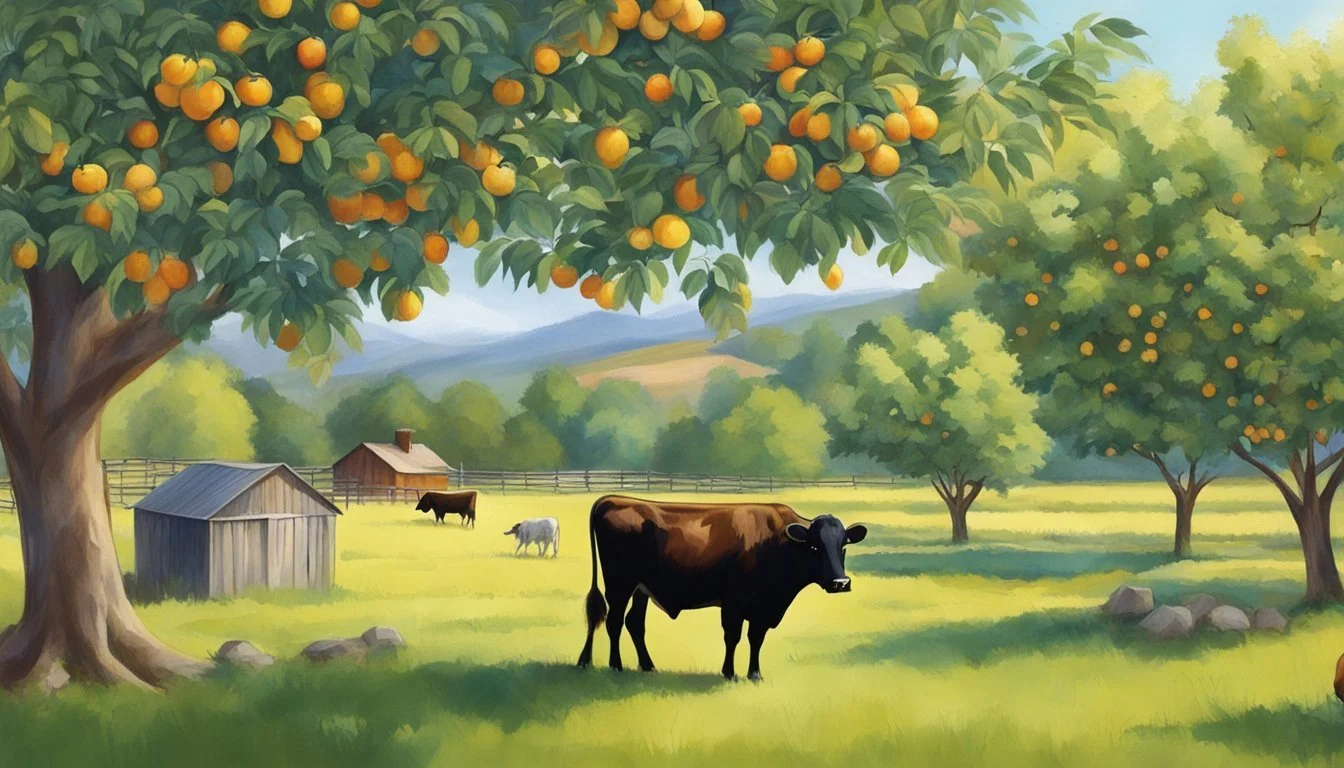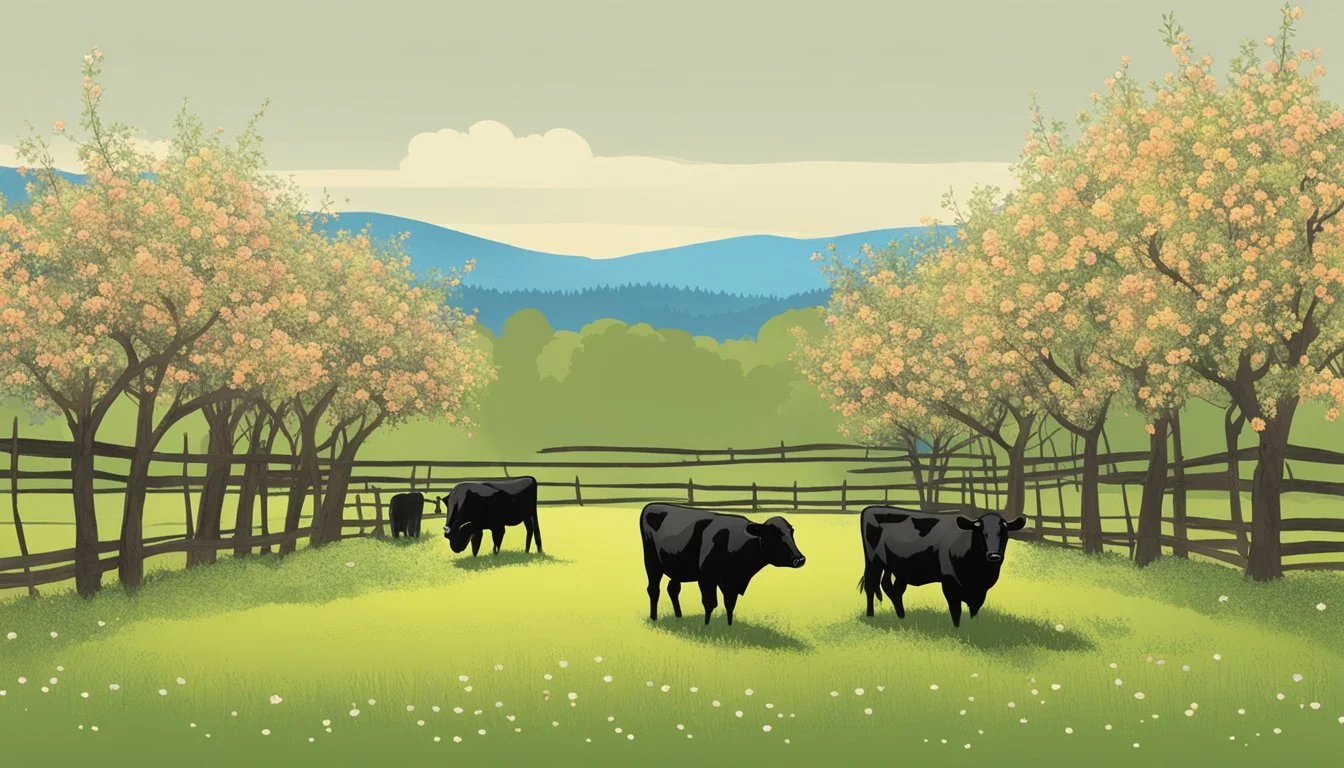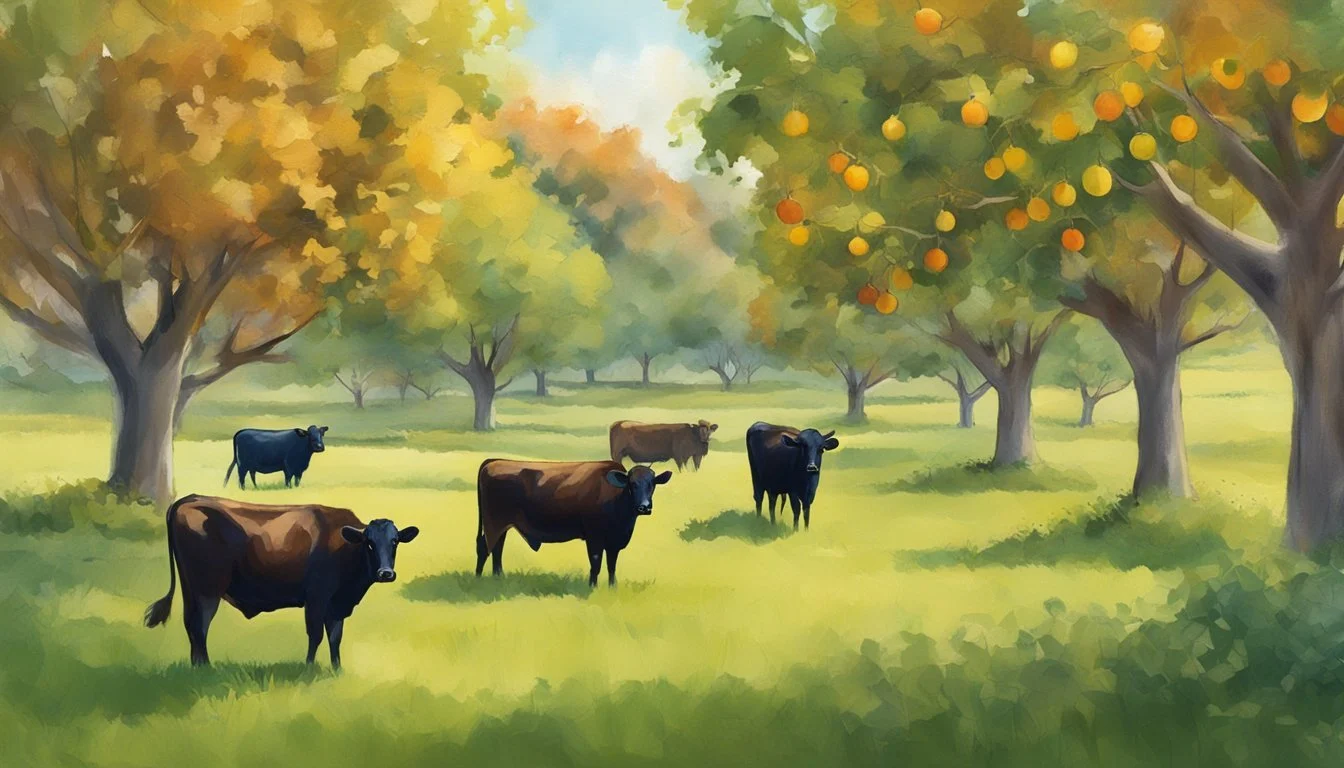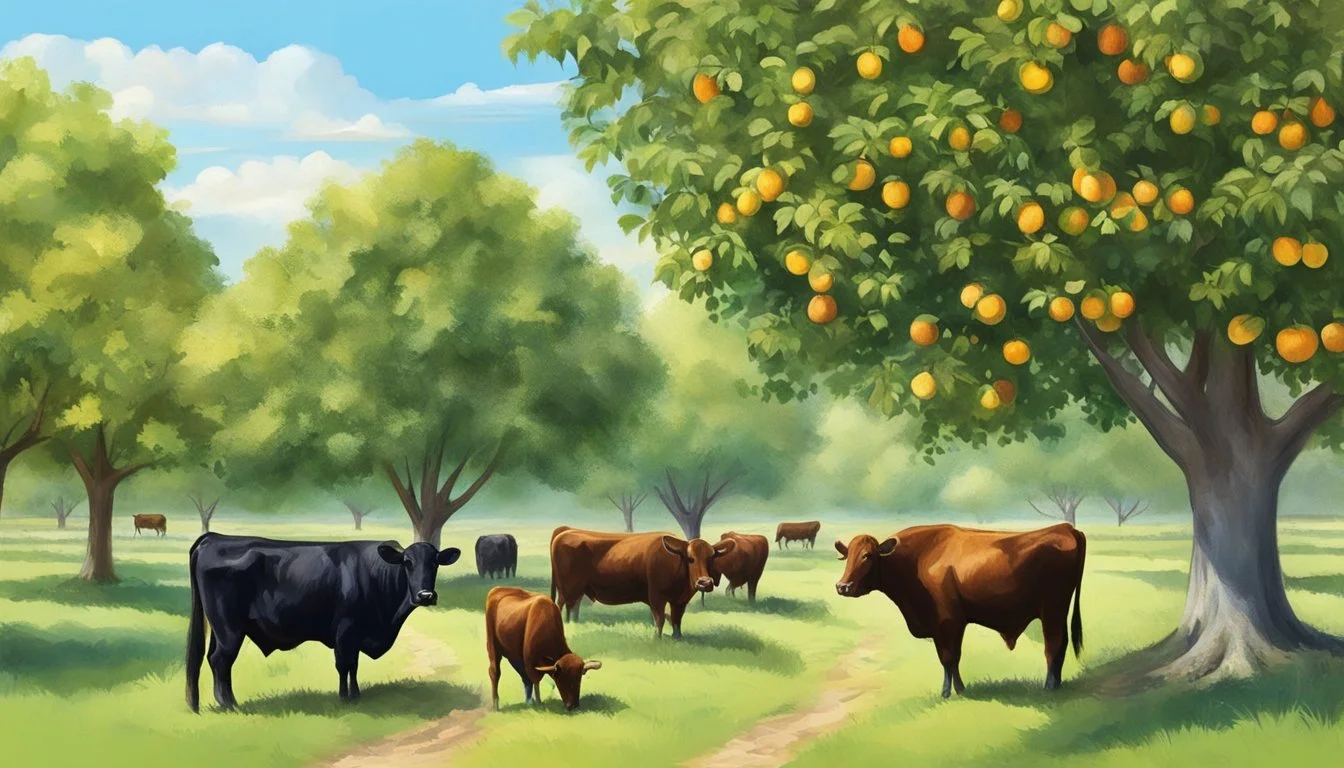Dexter Cattle and the Homestead Orchard
Integrating Livestock with Fruit Production
Dexter cattle, a small and hardy cattle breed, offers a unique synergy for homesteaders looking to maximize the productivity of their land. These cattle are not only efficient grazers but also integrate well within diverse agricultural systems, bringing benefits to orchards as much as they derive sustenance from them. When grazed among fruit trees, they contribute to the natural cycle of growth and fertility on a homestead, simplifying maintenance and enhancing sustainability.
Incorporating livestock grazing in an orchard setting is an example of agroforestry and is becoming a recognized practice for the myriad of advantages it provides. Dexter cattle, with their modest size and gentle disposition, are particularly well-suited for this role. They help manage ground cover, reducing weed competition and the need for mechanical mowing. Moreover, they naturally fertilize the soil with their manure, which in turn can promote healthier and more productive fruit trees.
For homesteads, the choice to integrate Dexter cattle into an orchard is a decision that can yield long-term rewards. Not only does this practice contribute to a closed-loop system that honors the principles of permaculture, but it also taps into the instincts of the cattle to forage diverse plants, which can lead to improved animal health. By carefully managing grazing patterns to ensure trees are not damaged and ground compaction is minimized, homesteaders can create a harmonious relationship between their cattle and orchard, reaping the benefits of both.
The Role of Dexter Cattle in Agroforestry Systems
Incorporating Dexter cattle into agroforestry systems, particularly homestead orchards, leverages their hardy nature and natural behaviors to benefit both livestock and the environment.
Understanding Silvopasture and Its Benefits
Silvopasture is an agroforestry practice that combines trees, forage, and the grazing of domesticated animals such as cattle on the same land. This sustainable farming system yields several benefits:
Enhanced Pasture: The presence of trees on pastureland improves soil quality and promotes diverse forage growth.
Climate Resilience: Agroforestry systems help mitigate climate change effects by reducing heat stress on animals and improving carbon sequestration.
Habitat for Wildlife: A variety of species find habitat in silvopasture ecosystems, supporting biodiversity.
Reduced Wildfire Risk: Silvopasture can lower wildfire risk through landscape diversification that reduces monoculture expanses.
Dexter Cattle: An Ideal Breed for Homestead Orchards
Dexter cattle are a small, robust breed that thrives within the silvopasture framework, making them suitable for homestead orchards. They offer several advantages:
Size and Temperament:
Dexter cattle are smaller than many other breeds, which means they are less likely to damage tree roots and bark.
Their calm disposition allows them to integrate well with farm activities and other livestock.
Foraging Behavior:
They efficiently convert diverse forages into milk and meat, and their grazing helps control undergrowth, which can minimize the risk of pests and diseases.
Adaptability to Varied Climates:
Dexter cattle are hardy and adaptable to different climates, reducing the stress on resources commonly seen in traditional cattle farming.
Table 1: Nutritional Benefits of Dexter Cattle in Agroforestry Systems
Benefit: Enhanced Milk Quality
Explanation: The varied diet from agroforestry systems may improve milk quality.
Benefit: Healthier Meat
Explanation: Grass-fed practices contribute to leaner and potentially more nutrient-dense meat.
By integrating Dexter cattle into homestead orchards, farms can create a resilient, productive, and sustainable agricultural system that respects the natural behavior of cattle, improves the land, and provides multiple outputs from timber to milk and meat.
Homestead Orchard Design and Planting
Developing a homestead orchard that supports grazing cattle, like the Dexter breed, requires a thoughtful design and informed planting strategies. Attention to vegetation diversity and soil considerations are paramount for a successful grazing-friendly orchard.
Selecting Diverse Plant Species for Grazing Orchards
Diversity is crucial in orchard plant species to support a resilient ecosystem. When selecting plant species, it's important to incorporate a mixture that not only produces fruit but can also withstand grazing pressure from cattle. Fruit trees such as mulberry are robust and can provide both shade and nourishment for cattle. The following is a strategic list of vegetation recommended for orchard grazing systems:
Mulberry Trees: Hardy species providing foliage and fruit for livestock.
Fruit Trees: Apple, pear, and cherry trees that offer high foliage and fruit above the grazing height.
Drought-resistant Plants: To cope with water scarcity and maintain soil conservation.
In choosing plant species, one also considers the harvest times to ensure staggered fruiting seasons, providing continuous grazing options.
Soil Type and Microclimate Considerations
The soil type and microclimate of a homestead are critical factors in orchard success. Soil testing should be carried out to determine pH levels, nutrient deficiencies, and the presence of organic matter, leading to a clear understanding of soil suitability for various plant species. Here is an outline of the factors to consider:
Soil Texture and Drainage: Identifies water retention capability, influencing irrigation needs.
Sunlight and Shade: Ensures appropriate sun exposure for optimal tree health and fruit production.
Wind Patterns and Elevation: Affects microclimate conditions around vegetation.
Adaptation practices may include adjusting plant choices to align with existing soil conditions, or amending the soil to suit the needs of chosen vegetation. Properly assessing microclimates aids in selecting spots within the orchard that optimize plant health and productivity, while acknowledging the potential for frost pockets or hot spots that can impact both the growth of plants and the comfort of cattle.
Grazing Management and Pasture Care
Effective grazing management and pasture care are crucial for maintaining a healthy balance between fruit tree productivity and cattle welfare. Dexter cattle, with their smaller stature, can be particularly suitable for grazing in an orchard setting without causing extensive damage to the trees.
Rotational Grazing for Soil Health and Tree Protection
Rotational grazing is a method where livestock is moved between different pasture areas to prevent overgrazing, allowing vegetation time to recover. Dexter cattle, along with compatible livestock such as sheep, can be utilized in a rotational grazing system to enhance soil health and protect the base of fruit trees from damage.
Grazing Management: Implementing rotations that align with the growth rate of forage can prolong the grazing season and prevent soil compaction around fruit trees.
Tree Protection: Using physical barriers such as fencing around trees can safeguard them from potential damage caused by livestock.
Fertilization and Soil Improvement Strategies
Fertilization and soil amendments play an important role in maintaining a productive pasture that can support both grazing and fruit production. Proper fertilization encourages the growth of desired grasses and forages like bahia and other nutrient-rich grasses that provide high-quality hay for livestock.
Fertilizer Use: Apply fertilizers in appropriate amounts; excess can lead to nutrient runoff and potential harm to fruit trees.
Soil Amendments: Lime can be used to adjust soil pH levels, improving nutrient availability for both forage and fruit trees.
Soil Types and Thinning: Understanding soil types is essential in determining the specific needs for fertilization and the potential need for thinning out shrubs to reduce competition for nutrients.
Enhancing Ecosystem Diversity and Productivity
Dexter cattle grazing among fruit trees in a homestead orchard contribute to an intricate ecological tapestry, where both flora and fauna thrive through mutualistic relationships. This interplay increases the yield and productivity by fostering a robust and healthful ecosystem.
Incorporating Wildlife and Bees into the Orchard
The Dexter cattle play an integral role by promoting plant species diversity through their selective grazing patterns. They facilitate seed dispersal and soil aeration, which can lead to varied and rich vegetation. This natural process supports a variety of wildlife, leading to enhanced biodiversity within the orchard.
Bees, as pivotal pollinators, find a diverse orchard ecosystem particularly conducive to their survival and productivity. The presence of Dexter cattle can indirectly lead to increased bee populations by maintaining open grassland areas where wildflowers—their primary food sources—can flourish. In turn, the enhanced bee activity elevates pollination rates, which is directly correlated with fruit yield throughout the seasons.
Conservation efforts in homestead orchards are bolstered by these practices, as they create a balance that favors both agriculture and native species conservation. This symbiosis is particularly important considering the varying seasonal demands of both plants and animals.
The culmination of these interactions is a dynamic and resilient orchard ecosystem, underpinned by Dexter cattle grazing patterns and the presence of wildlife and bees, which results in a sustainable and productive homestead landscape.
Seasonal Care and Climate Adaptation
Dexter cattle, known for their hardiness, adapt well to various environmental conditions, including those within a homestead orchard where trees provide a symbiotic relationship with grazing livestock.
Addressing Seasonal Changes and Weather Extremes
As the seasons shift, Dexter cattle require careful management to adapt to weather extremes, from the heat of summer to the chill of winter. In a homestead orchard setting, proper planning is essential for the wellbeing of both the cattle and the fruit trees.
Spring:
Grazing Rotation: Dexters should be rotated to encourage fresh growth of pasture and avoid damage to young trees.
Bud Protection: Fruit trees at budding stages need to be protected from potential harm caused by curious or hungry cattle.
Summer:
Shade Provision: Ample shade from the orchard trees is crucial to prevent heat stress in Dexter cattle. Trees should be spaced out adequately to create protective canopy coverage.
Water Access: Consistent water availability helps Dexters cope with high temperatures and maintain hydration.
Fall:
Fruit Drop: Cattle can benefit from fallen fruit as an additional food source but overeating must be prevented to avoid digestive issues.
Preparation for Winter: This is the ideal time for farmers to check the health status of their Dexters, ensuring they are prepared for colder months.
Winter:
Shelter: While Dexter cattle are resilient, they should have access to shelter to escape severe weather, particularly in regions prone to heavy snowfall or bitter cold.
Nutrition: Supplementation may be required as vegetation becomes sparse; stored forage like hay can be provided to maintain adequate nutrition.
Managing vegetation and factoring in climate changes ensure that Dexters navigate each season without undue stress. In drought conditions, water conservation practices become critical, and Dexter's foraging behavior can be an advantage as they are known to be efficient grazers even in less lush landscapes. It's a balance of leveraging the natural behavior of the cattle and the seasonal offerings of the orchard while being vigilant to protect the well-being of both.
Cattle Health and Welfare in Orchard Systems
Integrating Dexter cattle into orchard systems presents unique opportunities and challenges for cattle health and welfare, focusing on appropriate shelter and nutritional balance.
Shelter and Shade for Dexter Cattle
Dexter cattle, although smaller and hardier than many cattle breeds, still require adequate shelter and shade to maintain health and well-being. In the context of an orchard, natural tree canopy can provide essential shade, mitigating heat stress especially during the peak summer months. Shelter can also mean constructed housing to protect from inclement weather.
Shade Trees: Provide natural cooling areas and protection from direct sunlight.
Constructed Shelters: Essential for protection against rain, wind, and extreme weather conditions.
Provision of shade is critical not only for comfort but also to prevent health issues such as hip damage and overheating, which can impact milk production and overall cattle welfare.
Nutritional Requirements and Forage Quality
The quality of forage available in orchard systems must meet the specific nutritional needs of Dexter cattle. While grazing among fruit trees, they can benefit from the variety of grasses and occasional fallen fruit, which can add to their diet.
Pasture Quality: High-quality pasture that includes a mix of grasses is essential for basic nutrition.
Supplementary Hay: In periods when grazing is less available, such as winter, providing high-quality hay is necessary.
Attention to nutritional balance is essential to ensure that the milk and beef from Dexter cattle are of high quality. Careful management of the cattle's diet can prevent nutritional deficiencies and promote optimal health and productivity.
Economics of Dexter Cattle and Fruit Production
The integration of Dexter cattle into orchard systems offers potential economic benefits, leveraging the dual-use of land for enhanced yield and forage opportunities. This section breaks down the cost-benefit analysis of such an integration, focusing on economic viability and efficient land use.
Cost-Benefit Analysis of Integrating Livestock with Orchards
Integrating Dexter cattle into a fruit orchard can lead to a reduction in overall maintenance costs by utilizing the cattle for orchard floor management. Dexter cattle, known for their moderate size and gentle nature, are suitable for rotational grazing among fruit trees. This practice minimizes the need for mechanical mowing and contributes to soil health through natural fertilization. Farmers can expect to incur initial expenses related to fencing and the establishment of water access points for the livestock.
The presence of livestock within an orchard demands a careful evaluation of tree protection to prevent damage to young fruit trees or the timber. The cost of individual tree guards or a robust perimeter fence must be included in the analysis. However, these expenses can be offset by the multipurpose use of the land, which generates income not only from timber and yield of fruit but also from the sale of Dexter beef, known for its premium quality.
Benefits to Yield and Forage:
Forage: Dexter cattle effectively utilize grass and other orchard floor vegetation, which can reduce feed costs.
Fruit Yield: Healthier soil and reduced pest pressure can potentially increase fruit tree yield.
Economic Impacts on Farms:
Diversification: Turning orchard grass into a profitable product like Dexter beef can spread financial risk.
Reduced Inputs: Integrating livestock can lessen reliance on fertilizers and herbicides, translating to cost savings.
Livestock integration must balance orchard productivity with cattle needs. Dexter cattle require less space than larger breeds, which can be advantageous in smaller acreage orchards. Rotational grazing systems are essential to maintain forage availability, prevent overgrazing, and allow for sustainable fruit production.
Farmers should assess the market demand for both Dexter beef and orchard fruit to ensure that the integration provides a sound economic return. Market prices for premium Dexter beef may fluctuate, but its niche appeal can often command higher prices than commercial beef. Fruit trees also offer a long-term investment in timber value, which must be factored into the economic equation.
Challenges and Considerations for Landowners
Introducing Dexter cattle to homestead orchards can optimize land use and provide numerous benefits. However, managing the integration of livestock with fruit tree cultivation requires addressing specific concerns to safeguard both assets.
Managing Livestock-Crop Conflicts and Tree Damage
When Dexter cattle graze in orchards, they provide natural fertilization and aid in weed control. Nevertheless, landowners must mitigate potential livestock-crop conflicts to prevent damage to valuable fruit trees. Cattle may inadvertently harm young trees through rubbing or by eating bark and leaves, which can stunt growth or even kill the trees.
To avoid such conflicts, farmers should:
Protect young trees: Using tree guards or fencing can shield saplings from direct contact with the cattle. This is particularly crucial during a tree's early years when it is most susceptible.
Regularly inspect orchards: Frequent monitoring allows for the early identification of any signs of damage or stress on the trees, enabling timely interventions.
Shading is another concern; Dexter cattle might prefer resting under the trees, which can lead to soil compaction around the tree roots. To prevent this:
Landowners should provide alternative shade structures to discourage cattle from always congregating under fruit trees.
Strategically rotating grazing areas can help minimize the negative impact of shading and prevent soil compaction.
Wildlife conservation is critical; the presence of cattle can attract predators that might also pose a threat to the orchard. Proactive measures may include:
Installing deterrents: Utilizing fencing or guard animals can keep unwanted wildlife at bay.
Orchard layout planning: Designing the orchard to minimize edge habitats can help control wildlife interactions.
When considering the addition of Dexter cattle, landowners must also think about the thinning of timber. Strategic thinning can provide multiple benefits, such as improved grass quality for grazing and better sunlight penetration for the fruit trees. However, it must be done judiciously to maintain the ecological balance and ensure the health of the orchard.
Finally, planting resilient tree species, like mulberry, which can withstand grazing pressure better than others, might be a solution. These trees can offer an additional food source for the cattle while providing a sturdy canopy that enhances the orchard's diversity and productivity.
For successful integration, landowners must carefully weigh these considerations and implement practices that support both tree health and the well-being of Dexter cattle.
Sustainability and Conservation Practices
Incorporating Dexter cattle into orchard environments presents innovative strategies for sustainable land management and the bolstering of ecosystems.
Using Dexter Cattle for Land Management and Conservation
Dexter cattle, due to their size and hardy nature, are an ideal choice for land management in orchard landscapes. Their smaller stature means they cause less compaction to the soil, which can preserve the soil structure and health, crucial for both pasture growth and the root systems of fruit trees. Furthermore, the grazing patterns of Dexter cattle help manage forage growth, reducing the need for mechanical mowing and thus contributing to reductions in carbon emissions.
The cattle's grazing activity plays a significant role in conservation efforts. They contribute to a diverse ecosystem by maintaining open areas clear of aggressive shrubs and by promoting the growth of various plant species. This not only aids in wildlife biodiversity by providing habitats and forage but also improves the ecological balance of the orchard itself.
Dexter cattle are integrated into a grazing management plan that can enhance climate resilience. Strategic grazing provides shade and habitat for beneficial insects and other wildlife, contributing to the overall health of the orchard. By cycling nutrients and fostering a mix of plant life, they help enrich the biodiversity of the area.
Moreover, the breed's adaptability to different soil types and conditions makes them versatile for such conservation grazing methods. This practice not only bolsters the climate resilience of the farmland but also supports a rich tapestry of biodiversity, enhancing the sustainability of the orchard ecosystem. Through mindful management, Dexter cattle serve as living tools that support orchard health, soil fertility, and the broader objectives of ecosystem conservation and sustainability.
Dexter Cattle Breeding and Genetics
Dexter cattle are a breed known for their durability and aptitude in various climates, making them an excellent choice for both beef and dairy production. This section examines their robust genetic characteristics, particularly in the context of breeding programs aimed at enhancing climate adaptability.
Raising Hardy Dexter Bulls and Cows for Diverse Climates
Dexter cattle originate from Ireland, but they have been bred in America to withstand the diverse and harsh climates. They are a smaller breed of cattle, with a mature bull weighing between 1,000 to 1,200 pounds and a cow between 750 to 850 pounds. Their size contributes to their versatility, as they can be raised in varied environments—from the windswept hills of their native Ireland to the more extreme conditions seen in parts of America.
Genetics play a crucial role in the hardiness of Dexters; they carry a set of genes that endow them with resilience and efficiency in resource use, which is beneficial in homestead orchards where they often graze among fruit trees. Their genetic makeup results in cattle that can produce high-quality beef with less feed compared to larger breeds.
The Dexter coat can vary in color, most commonly being black, but can also include shades of dun, red, or even a mix of these colors. This variance can be significant for breeding as it pertains to the cattle's adaptability to sun exposure and climate-related stress.
Hip health is also a genetic consideration in Dexter cattle, as with all cattle breeds, and breeders should ensure that their stock has structurally sound hips to avoid complications. Genetic testing has become a tool for Dexter cattle breeders to manage their breeding programs effectively, with a specific focus on eliminating potential hereditary conditions like Bulldog Dwarfism (Chondrodysplasia), a lethal genetic defect specific to Dexter cattle.
By selecting for strong genetic traits, breeders can further enhance the hardiness of the Dexter breed, ensuring that these bulls and cows are well-suited for homestead orchards and diverse climates. Dexter cattle demonstrate a remarkable ability to thrive in a variety of environmental conditions, underlining the breed's significance in sustainable agriculture practices across America.
Integrating Other Livestock with Dexter Cattle
Integrating Dexter cattle with other livestock such as sheep and horses can optimize pasture usage and improve the health of the orchard ecosystem through complementary grazing.
Synergies Between Dexter Cattle, Sheep, and Horses
Sheep are excellent grazers that can coexist with Dexter cattle, often eating plants and grasses cattle avoid. By incorporating sheep into a Dexter cattle grazing system, the efficiency of pasture utilization is increased. They have different foraging behaviors and preferences which can lead to a more uniform grazing pattern.
Pasture Management: Sheep can help control weeds and encourage new grass growth, which cows can benefit from.
Parasite Control: Different livestock species are affected by different parasites, reducing the parasite load for all animals involved.
Horses, on the other hand, complement Dexter cattle by grazing on taller grasses that cattle might not prioritize.
Grazing Patterns: Horses clip grass closely, which can aid in the even distribution of grass length and prevent certain areas from becoming overgrown.
Pasture Maintenance: Their grazing can reduce the need for mechanical mowing, promoting more natural orchard maintenance.
Rotational Grazing is a key aspect of integrating these livestock types. By rotating cattle, sheep, and horses through different pasture segments, grasses can regenerate.
Grazing Management: This system helps to maintain the health and sustainability of the pastures.
Health Benefits: It also decreases the likelihood of disease and parasite transmission between animals.
Incorporating a mix of Dexter cattle, sheep, and horses can create a vibrant and sustainable pasture-based ecosystem that benefits the health of the livestock and the productivity of the land.
Marketing and Selling Dexter Cattle and Orchard Products
When it comes to Dexter cattle and orchard management, effectively marketing and selling beef and fruit yields can be exceptionally rewarding for American landowners. Establishing a strong brand and employing niche marketing strategies are crucial for differentiating products in the competitive agricultural market.
Branding and Niche Marketing for Dexter Beef and Orchard Fruits
Dexter Beef: Landowners can increase the marketability of Dexter cattle by focusing on their unique characteristics. Dexters are known for being a hardy and versatile breed, well-suited for a range of climates, and capable of thriving on pasture-based diets. Their smaller size provides a yield that is manageable for direct-to-consumer sales, targeting consumers interested in sustainable and ethically-raised beef. Highlighting these points in branding can result in better prices and a more dedicated customer base.
Key Strategies:
Develop a story brand that connects customers to the breed's Irish heritage and sustainable farming practices.
Emphasize the quality and flavor profile of Dexter beef in marketing materials.
Leverage social media platforms to reach niche markets interested in small-scale, ethical meat production.
Orchard Fruits: Marketing orchard fruits involves promoting the natural and healthful aspects of the produce. With the increase in demand for locally-sourced and organic fruits, landowners can market their orchard yield by emphasizing the freshness and nutritional benefits. Branding should communicate the quality of the fruit, as well as any unique varieties or heirloom species grown within the orchard.
Key Strategies:
Use clear labeling with bold fonts to highlight organic certification or other desirable qualities of the fruits.
Offer taste-testings at local farmer's markets to introduce the distinct flavors of orchard fruits.
Create visually appealing packaging to attract consumers and build brand recognition.
By strategically marketing the distinctive qualities of both Dexter beef and orchard fruits, landowners in America can effectively reach targeted consumer segments. The branding should be consistent across all platforms and packaging to create a strong, recognizable image that resonates with consumers looking for high-quality, sustainable products.


